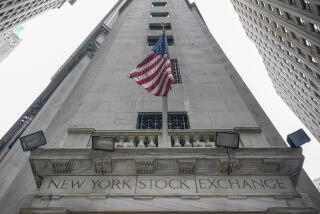U.S. Unfazed by Record Decline in S&L; Deposits
- Share via
Deposits have been flowing from the nation’s savings and loans at a record rate in recent weeks, but regulators insist that there is no “silent run” on thrifts.
Instead, experts say, the deposit outflow is due in part to decisions by savers to cash in on higher rates being offered in alternative investments such as Treasury bills or money market mutual funds, as well as actions by some thrifts to deliberately reduce their deposits.
“I don’t think it’s a run,” said James R. Barth, chief economist for the Federal Home Loan Bank Board, the chief regulator of S&Ls.; “There’s no evidence that depositors were running from S&Ls; during December or November.”
Analysts add that the deposit outflows of $8.1 billion in December--a record for any month--still represent less than 1% of the $972 billion in S&L; deposits nationwide. And when savers’ interest earnings of $8.4 billion in December are added in, deposits on a net basis still grew in December by slightly more than $300 million.
Nonetheless, the deposit outflow is a growing cause of concern among many thrift executives and regulators.
6% Plan Withdrawal, Poll Shows
The December outflow followed a $7-billion deposit decline in November. Figures for January are expected to show continued erosion, particularly in the days following the Treasury Department’s suggestion that a deposit tax be levied to help finance thrift bailouts.
A new Money magazine survey suggests a larger outflow, with funds being removed from S&Ls; and banks at the rate of $6 billion a week late last month.
An ABC News poll showed 6% of people with S&L; accounts are planning to withdraw their money soon because of the S&L; crisis.
Such continued loss of deposits could have serious repercussions for the S&L; industry and the Bush Administration’s handling of the crisis.
President Bush’s plan to inject new monies into the thrift industry’s insolvent insurance fund includes boosting insurance premiums charged to S&Ls.; Those premiums are charged as a percentage of their total deposits.
But the $90-billion price tag for the bailout assumes annual growth in S&L; deposits of 7%, an estimate that many outside experts say is overly optimistic. Thus, taxpayers may be asked to foot even a greater burden in financing the bailout.
“What this may suggest is that the Administration’s assumptions that deposits will grow at a 7% rate ad infinitum is very dubious,” said Bert Ely, a S&L; consultant in Alexandria, Va.
Furthermore, publicity about deposit outflows could generate more fears among savers, which in turn could generate additional withdrawals. And the fact that there are any withdrawals at all due to the S&L; crisis suggests that many depositors still may distrust the safety and reliability of federal deposit insurance, which protects accounts of the same category up to $100,000 per institution.
“We’re just hopeful that people are aware they are protected, and if they decide to withdraw, that they don’t incur penalties needlessly,” said James H. Grohl, senior vice president at the U.S. League of Savings Institutions, the industry’s chief trade group.
But so far evidence of panic withdrawals is slim.
With some exceptions, depositors by and large have reacted calmly to the mounting news of S&L; woes, knowing that their savings are protected as long as they fall within the $100,000 limit of federal deposit insurance. While some executives of thrifts mentioned as likely candidates for federal takeovers have reported some increases in withdrawals, most thrifts say it has been business as usual.
Instead, much of the outflow is due to intentional actions by thrifts trying to reduce their level of deposits, or being forced to keep a lid on the high interest rates they had paid previously on savings accounts.
Bank board economist Barth said that of the $8.1 billion flowing out of S&Ls; in December, $3.4 billion was laid to one healthy thrift in California that was intentionally trying to shrink its deposits; that could be accomplished by not aggressively seeking new deposits and by not asking holders of maturing certificates of deposit to roll over their funds. It was replacing those deposits with other funds it could obtain at lower rates than the rates it paid depositors, Barth said.
However, spokespersons for several large healthy California S&Ls;, including American Savings, Home Savings, Great Western, California Federal, Glendale Federal and Home Federal, denied on Monday that they were the thrift that reduced deposits by that amount.
Another $3 billion came from 15 institutions, some also healthy firms that also were replacing deposits with funds it could obtain at lower costs, bank board economist Barth said. Others among the 15 were ailing Texas institutions that were prodded by the bank board to cut interest rates on their deposits to lower their costs. With less-attractive rates, many savers may have taken their deposits elsewhere.
Institutions also may have decided to keep their deposit rates down or avoid new deposits because they would have to raise rates too high to become competitive with Treasury securities and money market mutual funds, Ely suggests.
Money market mutual funds, for example, are paying an average of 8.72%, their highest rate in four years and more than 2 percentage points over average rates on bank and S&L; money market deposit accounts. Money market mutual funds also are paying more on average than six-month and one-year certificates of deposits.
As a result, some savers are undoubtedly moving money from S&Ls; into alternatives. Net inflows into money market mutual funds totaled $10.8 billion in November and $6.2 billion in January, according to Susan M. Cook, editor of Donoghue’s Money Fund Report. Those funds suffered a $1.9-billion outflow in December, but that was a typical seasonal factor due to holiday gift spending.
More to Read
Inside the business of entertainment
The Wide Shot brings you news, analysis and insights on everything from streaming wars to production — and what it all means for the future.
You may occasionally receive promotional content from the Los Angeles Times.









